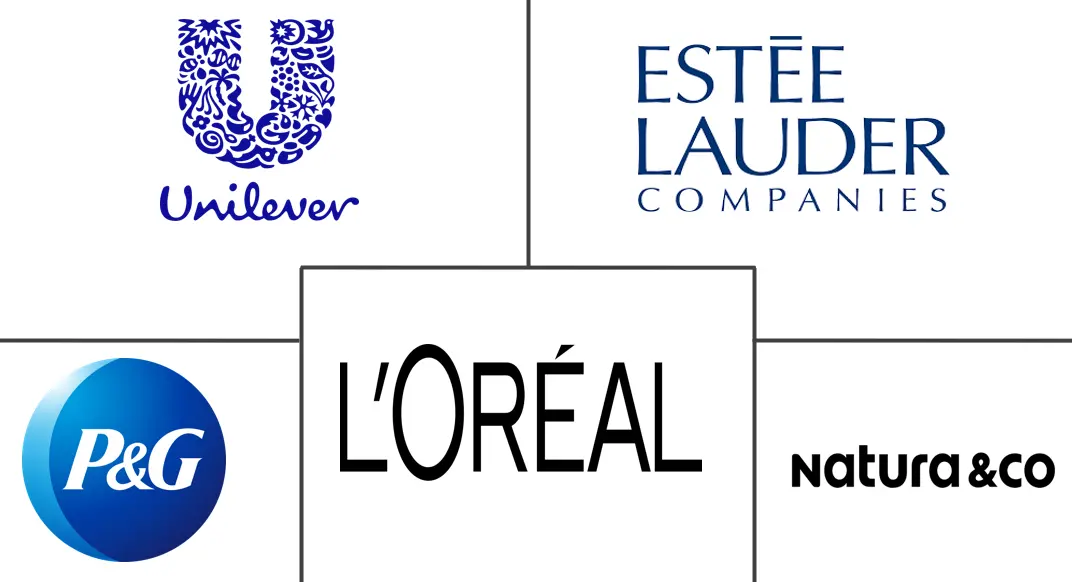E-Commerce Personal Care Products Market Size and Share
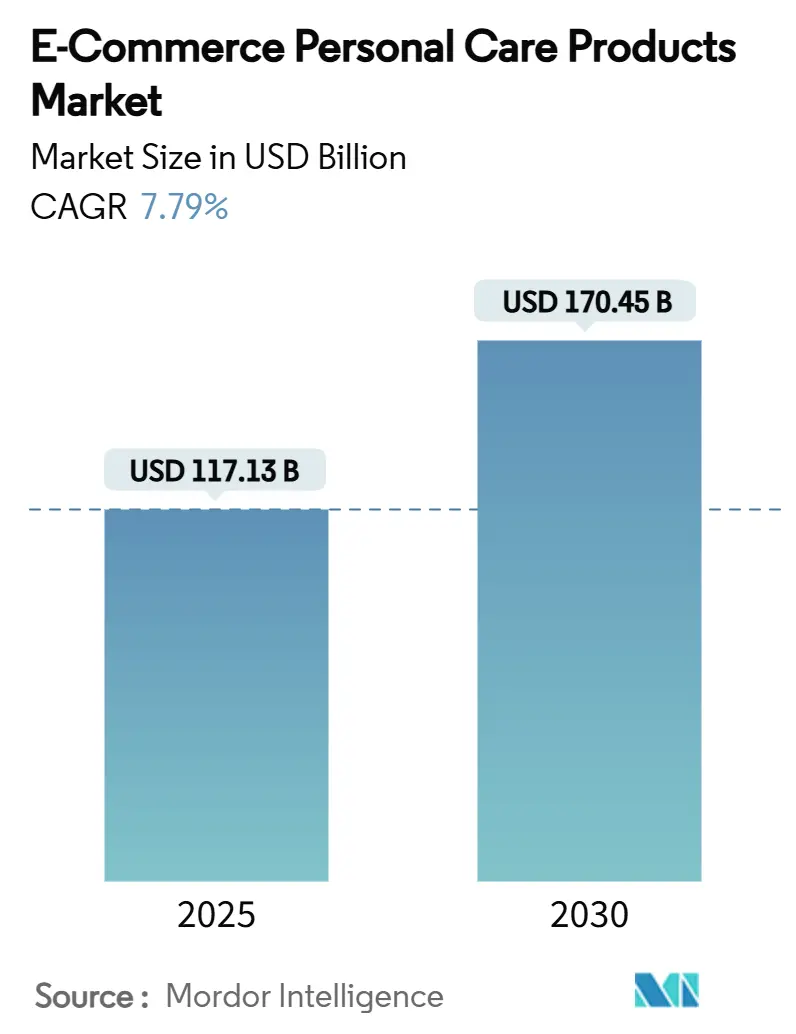
E-Commerce Personal Care Products Market Analysis by Mordor Intelligence
The global e-commerce personal care products market is estimated to be USD 117.13 billion in 2025 to USD 170.45 billion by 2030, at a compound annual growth rate (CAGR) of 7.79%. This growth stems from multiple factors transforming consumer behavior and industry dynamics. The increased adoption of digital technologies and broader internet access have made online shopping more accessible. Furthermore, the widespread use of smartphones and enhanced logistics networks enables efficient purchasing processes. Consumers demonstrate a strong preference for e-commerce platforms due to their convenience, product variety, and transparency in comparing products, prices, and reviews. The market's expansion is primarily driven by AI-enabled personalization features, including product recommendations, virtual try-ons, and customer service chatbots that enhance the overall shopping experience. Direct-to-consumer (DTC) brands are strategically utilizing these digital capabilities to implement competitive pricing strategies and establish direct customer relationships without traditional retail intermediaries, thereby contributing significantly to the market's continued growth trajectory.
Key Report Takeaways
- By product type, skin care led with 41.65% revenue share in 2024, while hair care is projected to expand at an 8.25% CAGR to 2030.
- By ingredient, conventional formulations captured 72.23% of the e-commerce personal care products market share in 2024; natural and organic formats are forecast to grow at a 9.32% CAGR through 2030.
- By category, mass items commanded 73.23% of the e-commerce personal care products market size in 2024; premium items are advancing at an 8.86% CAGR to 2030.
- By platform type, third-party marketplaces captured 88.27% share in 2024, while company-owned sites are growing faster at a 9.65% CAGR to 2030.
- By geography, Asia-Pacific held 42.43% of global value in 2024 and is set to record a 10.34% CAGR to 2030.
Global E-Commerce Personal Care Products Market Trends and Insights
Drivers Impact Analysis
| Driver | (~) % Impact on CAGR Forecast | Geographic Relevance | Impact Timeline |
|---|---|---|---|
| Influence of social media and influencer marketing | +1.8% | Global, strongest in Asia-Pacific and North America | Medium term (2-4 years) |
| Flexible and diverse payment options | +0.9% | Global, with emphasis on emerging markets in Asia-Pacific | Short term (≤ 2 years) |
| Promotion and discounts enticing consumer to make purchase | +1.2% | Global, with higher impact in North America and Europe | Short term (≤ 2 years) |
| Demand for clean, suitable and ethical products | +1.5% | Global, led by Europe and North America premium segments | Long term (≥ 4 years) |
| Increasing trend of online shopping | +2.1% | Global, with accelerated adoption in Asia-Pacific | Medium term (2-4 years) |
| Personalization and product recommendations | +1.3% | Global, technology-driven markets leading adoption | Long term (≥ 4 years) |
| Source: Mordor Intelligence | |||
Influence of Social Media and Influencer Marketing
The E-commerce personal care products market has transformed its promotional strategies, with social commerce emerging as a key growth driver. Digital payment system integration has accelerated this transformation. In October 2024, Press Information Bureau reported that Unified Payments Interface (UPI) processed INR 16.58 billion financial transactions in a single month, demonstrating its importance in India's e-commerce digital transformation [1]Source: Press Information Bureau (PIB), "Revolutionizing Digital Payments in India", pib.gov.in. This change is significant for international beauty brands targeting younger consumers, who discover products through digital content creators rather than traditional advertising channels. Nano-influencers, content creators with smaller but highly engaged international followings, have become valuable partners for global beauty brands seeking authentic consumer connections. These influencers deliver higher engagement rates and conversion metrics compared to macro-influencers while providing brands with targeted reach at lower costs. International brands such as Rare Beauty exemplify this strategy's success in the e-commerce space, gaining significant market share through creator-driven content despite recent market entry.
Flexible and Diverse Payment Options
The availability of flexible payment options drives growth in the e-commerce personal care products market by transforming consumer shopping behavior and increasing conversion rates. Consumers expect secure and customized payment experiences with options ranging from traditional credit cards to digital wallets. Digital wallets now facilitate a significant portion of global online payments, offering one-click purchasing and enhanced security that reduces transaction friction and cart abandonment rates. According to the United States Securities and Exchange Commission, PayPal's global payment transaction volume increased by over 5% in Q3 2024 compared to Q3 2023. The integration of diverse payment solutions remains essential for e-commerce platforms to maintain market competitiveness and meet evolving consumer preferences in the personal care products segment. As digital payment technologies continue to advance, businesses that adapt to these payment trends position themselves for sustained growth in the online personal care products marketplace.
Promotion and Discounts Enticing Consumer to Make Purchase
Promotional methodologies and pricing optimization strategies demonstrate substantial influence on consumer purchasing patterns within the e-commerce personal care products market, functioning as fundamental mechanisms for customer acquisition and retention initiatives. Organizations systematically implement diverse discount methodologies, encompassing time-sensitive offerings, comprehensive sales initiatives, digital voucher systems, promotional code implementations, and Buy One Get One Free (BOGO) incentive structures, to facilitate consumer engagement and expedite transaction completion processes. Major beauty retail establishments execute temporary price reduction strategies and initial purchase incentive programs to expand their consumer base, while established market participants employ promotional code systems and digital incentive frameworks to optimize transaction completion metrics. Interactive promotional mechanisms, incorporating randomized reward distribution systems and engagement-driven incentive structures, enhance the consumer experience paradigm and facilitate incremental purchase decision processes.
Demand for Clean, Suitable and Ethical Products
The e-commerce personal care products market is experiencing a fundamental transformation driven by escalating consumer demand for clean, sustainable, and ethical products. Consumer consciousness regarding ingredient composition, sustainability practices, and ethical considerations continues to influence purchasing patterns, compelling manufacturers to restructure their product portfolios accordingly. In March 2023, Walmart implemented a strategic initiative by introducing a clean beauty shop comprising 900 products that exclude harmful substances such as formaldehyde and PFAS, thereby enhancing accessibility to safer personal care alternatives. Market participants have systematically integrated ingredient transparency protocols, sustainable sourcing methodologies, and cruelty-free certifications to address evolving market requirements. The incorporation of refillable packaging solutions and environmentally conscious shipping practices has become an essential market standard, signifying a sustained transition toward cleaner and more ethical personal care products in the e-commerce landscape.
Restraints Impact Analysis
| Restraint | (~) % Impact on CAGR Forecast | Geographic Relevance | Impact Timeline |
|---|---|---|---|
| Proliferation of counterfeit and unsafe products | -1.4% | Global, with highest impact in Asia-Pacific and emerging markets | Medium term (2-4 years) |
| Logistical challenges in fulfillment and delivery | -0.8% | Global, particularly affecting rural and remote areas | Short term (≤ 2 years) |
| Intense price competition reduces profit margins | -1.1% | Global, most pronounced in mass market segments | Medium term (2-4 years) |
| Data privacy concerns limit personalization opportunities | -0.6% | Europe and North America leading regulatory restrictions | Long term (≥ 4 years) |
| Source: Mordor Intelligence | |||
Proliferation of Counterfeit Products Undermines Consumer Trust
The expansion of the global e-commerce personal care products market is significantly impeded by the prevalence of counterfeit merchandise, which presents substantial risks to consumer well-being and corporate brand integrity. This critical issue manifests predominantly within third-party e-commerce platforms, where product authentication mechanisms remain insufficient. The Food and Drug Administration (FDA)'s implementation of the Modernization of Cosmetics Regulation Act (MoCRA) has established enhanced enforcement protocols, with 589,762 active cosmetic product listings documented by January 2025, facilitating the identification of fraudulent products [2]Source: Food and Drug Administration (FDA), "2024 Office of the Chief Scientist Year-In-Review External Report", fda.gov. E-commerce platforms are subject to increased regulatory accountability under revised frameworks, including the elimination of the de minimis exemption for low-value shipments, which has strengthened customs surveillance and necessitated the implementation of more rigorous seller verification protocols. Despite these challenges, the e-commerce personal care products market continues to evolve through enhanced regulatory compliance, improved authentication systems, and strengthened supply chain protocols, ensuring sustained market development and consumer protection.
Logistical Challenges in Fulfillment and Delivery
The e-commerce personal care products market faces significant operational constraints due to logistics challenges in fulfillment and delivery systems. The complexity of managing diverse product formulations, packaging specifications, and regulatory compliance across international markets presents substantial barriers for companies seeking global expansion. Companies must navigate intricate customs procedures while adhering to region-specific packaging and ingredient regulations. Failure to meet these requirements results in operational delays, increased operational costs, and potential market access restrictions. The market experiences heightened pressure during peak seasons, including holidays, New Year, Valentine's Day, and back-to-school periods, which strain logistics networks and lead to inventory management issues and fulfillment delays. These operational challenges underscore the critical need for robust supply chain infrastructure and comprehensive regulatory compliance frameworks to ensure sustainable market growth and maintain competitive advantage in the global e-commerce personal care products landscape.
Segment Analysis
By Product Type: Skin Care Dominates Digital Beauty Landscape
The skin care segment maintains market dominance with a 41.65% share in 2024, attributed to consumer emphasis on preventive wellness solutions and ingredient efficacy rather than traditional color cosmetics. The hair care segment demonstrates the highest growth trajectory, registering an 8.25% CAGR through 2030, primarily driven by technological innovations exemplified by L'Oréal Groupe's AirLight Pro, a professional-grade hair drying instrument introduced in January 2024. The lip care segment exhibits significant recovery, corresponding to the resumption of social activities in the post-pandemic period, generating increased demand for products that deliver both hydration and aesthetic enhancement.
The oral care segment demonstrates sustained growth through the implementation of subscription-based business models and the integration of electric toothbrushes with mobile applications for dental hygiene monitoring. The men's grooming segment exhibits substantial expansion, notably in Asian markets, where male consumers demonstrate increased adoption of skincare and cosmetic products. The fragrance market undergoes transformation through the implementation of personalization technologies, facilitating customizable scent development, while premium offerings emphasize therapeutic and psychological benefits.
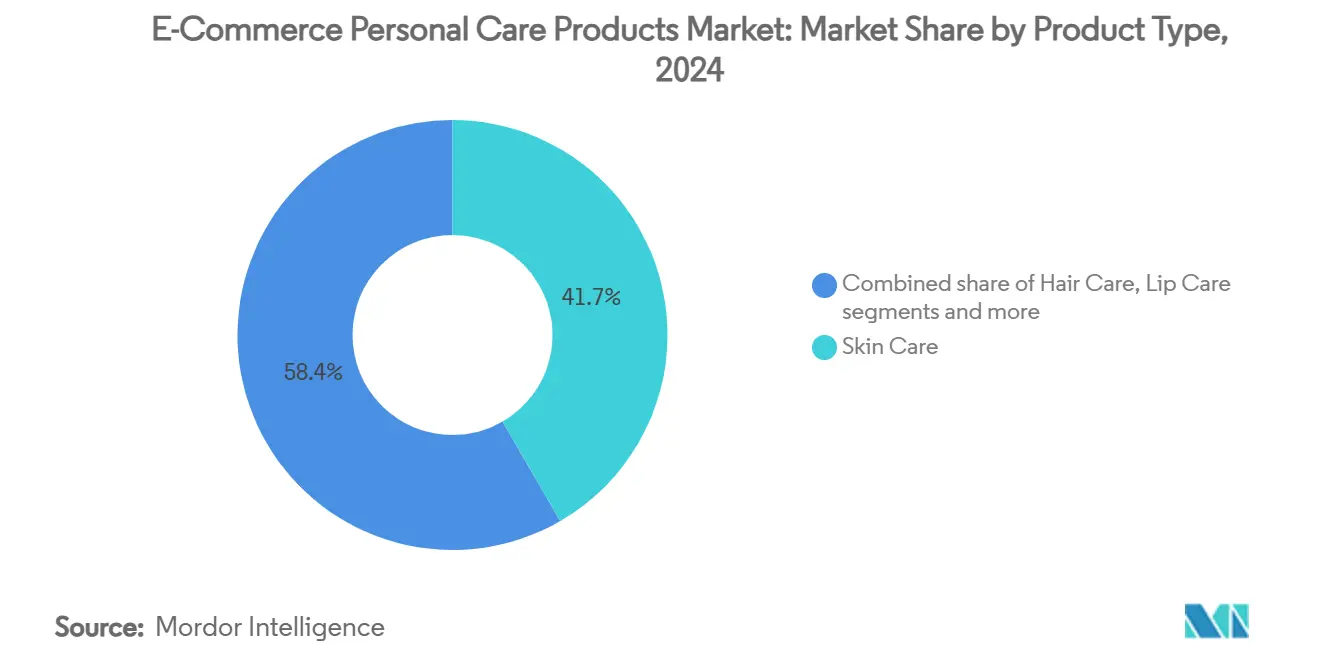
Note: Segment shares of all individual segments available upon report purchase
By Ingredients: Natural and Organic Products Reshape Market Dynamics
In 2024, conventional/synthetic ingredients dominate the global e-commerce personal care products market with a 72.23% market share. This position stems from established supply chains that provide consistent product availability and cost efficiencies for manufacturers and retailers. Synthetic formulations maintain their appeal through proven efficacy, stability, and scalability, particularly among price-sensitive consumers in mass market segments where affordability and consistent results are essential. Major brands utilize these advantages to maintain wide distribution networks and competitive pricing, making conventional products the primary choice for consumers globally. The market position of synthetic ingredients remains strong due to consumer familiarity and established trust.
The natural and organic formulations segment is expected to grow at a 9.32% CAGR through 2030. This growth reflects increased consumer focus on health, wellness, and environmental sustainability, along with greater demand for clean-label products without synthetic chemicals. Millennials and Gen Z consumers prioritize transparency in ingredient sourcing and manufacturing processes, increasing demand for plant-based, cruelty-free, and environmentally conscious products. Manufacturers are developing new formulations, implementing sustainable packaging solutions, and obtaining certifications to meet consumer preferences. The combination of premium natural and organic products with digital marketing strategies is driving adoption across both developed and emerging markets.
By Category: Premium Segment Drives Value Growth in Online Beauty
Mass products currently hold a dominant position in the global e-commerce personal care products market, accounting for 73.23% of market share in 2024. Prevailing economic conditions have heightened consumer price sensitivity, resulting in increased value-oriented purchasing patterns. This behavioral shift encompasses prestige consumers who now demonstrate cross-tier purchasing tendencies. Mass products maintain their market dominance through extensive distribution networks, competitive price points, and demonstrated product efficacy, particularly during periods of economic uncertainty. Established supply chain infrastructure, systematic promotional strategies, and comprehensive online marketplace presence further consolidate the position of mass-market products in the global market.
The premium segment exhibits a substantial growth trajectory, with projections indicating a compound annual growth rate of 8.86% through 2030. This expansion is attributed to increasing disposable income levels, heightened consumer demand for advanced formulations, and growing preference for customized luxury experiences. Premium brands strengthen their market position through technological innovation, strategic influencer collaborations, and targeted online product introductions. The proliferation of wellness and self-care trends has increased consumer propensity to invest in superior quality, efficacious, and sustainable products. While premium products constitute a smaller market share relative to mass products, their growth trajectory indicates an evolving consumer preference toward premium personal care offerings.
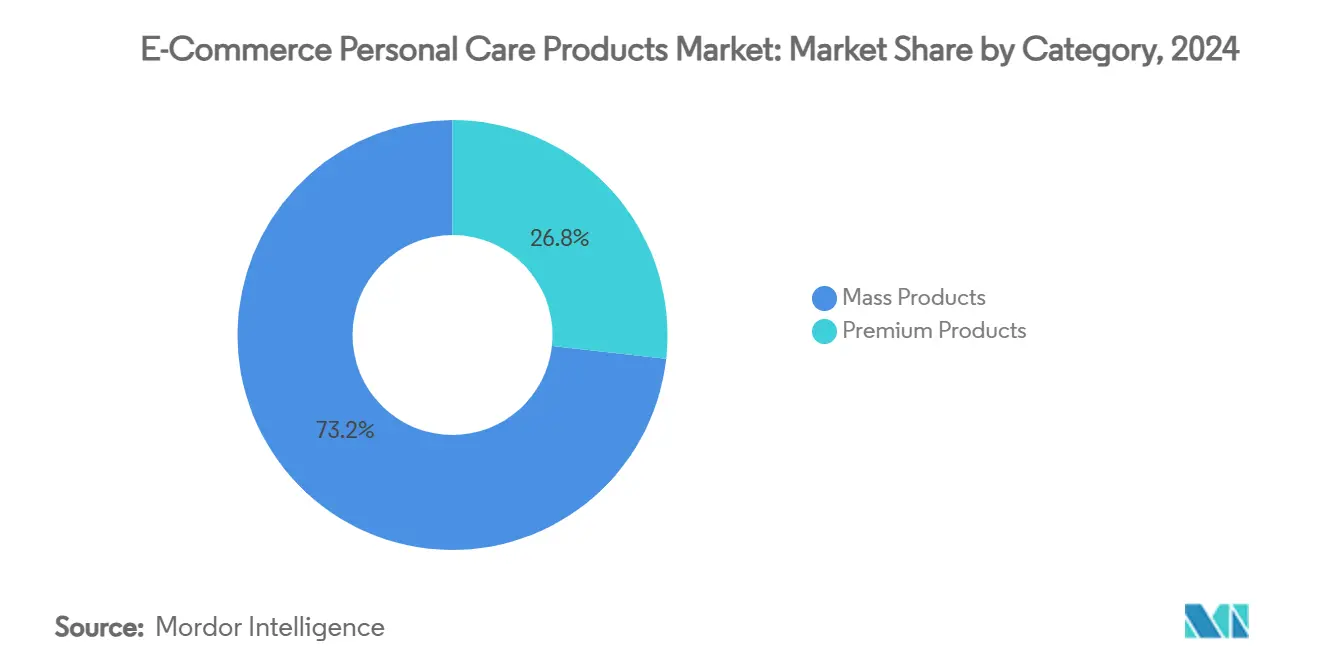
By Platform Type: Growth and Strategic Importance of Company-Owned Platforms
Third-party marketplaces dominate the global e-commerce personal care products market in 2024, holding an 88.27% platform share. Consumers prefer these platforms for their ability to compare products, access competitive prices, and complete consolidated purchases. Major marketplaces like Amazon, Tmall, Flipkart, and Shopee enable customers to purchase multiple brands and categories in a single transaction. These platforms attract consumers through customer reviews, regular promotions, and efficient shipping services. For brands, these marketplaces provide extensive market reach and visibility across diverse consumer segments.
Company-owned platforms, despite their smaller market share, are expected to grow at a 9.65% CAGR through 2030. This growth stems from increased adoption of direct-to-consumer (DTC) strategies, which facilitate customer engagement and personalization. Through proprietary websites and applications, companies offer exclusive products, personalized recommendations, and loyalty programs. These platforms provide brands with greater control over customer data, relationships, and pricing strategies. As consumers increasingly value authenticity and transparency, company-owned platforms are becoming more significant in the e-commerce personal care market.
Geography Analysis
Asia-Pacific region commands 42.43% market share in 2024 and demonstrates a projected growth rate of 10.34% CAGR through 2030, attributed to China's digital retail market evolution. Southeast Asia is establishing its position as a significant beauty e-commerce market, underpinned by demographic shifts toward middle-class expansion and increased internet infrastructure development. The regional market demonstrates notable advancement through the integration of livestreaming and social commerce capabilities, with platforms such as Alibaba providing essential market access in developing regions. International beauty corporations, including L'Oréal and Estée Lauder, have realized substantial returns on their digital infrastructure investments.
North America retains its market leadership position in e-commerce personal care products, exhibiting sustained growth trajectories notwithstanding political market variables. This market expansion is fundamentally supported by elevated disposable income levels, established personal care routines, and increasing consumer focus on dermatological and hair maintenance requirements, driving demand for multifunctional product innovations. Market development continues through digital platform optimization, enhanced e-commerce user experiences, and strategic integration of social media marketing and celebrity product endorsements.
European markets maintain a significant market presence in online beauty commerce operations. The region demonstrates pronounced environmental consciousness, evidenced by IfD Allensbach data indicating 21.91 million German-speaking consumers expressing willingness to increase expenditure on environmentally sustainable products in 2024 [3]Source: IfD Allensbach, "Number of people in Germany who are willing to pay more for environmentally friendly products", ifd-allensbach.de. South America, and Middle East and Africa regions present emerging market opportunities, characterized by expanding middle-class demographics and increasing disposable income levels. However, these regions experience growth limitations due to infrastructure deficiencies and regulatory framework complexities.
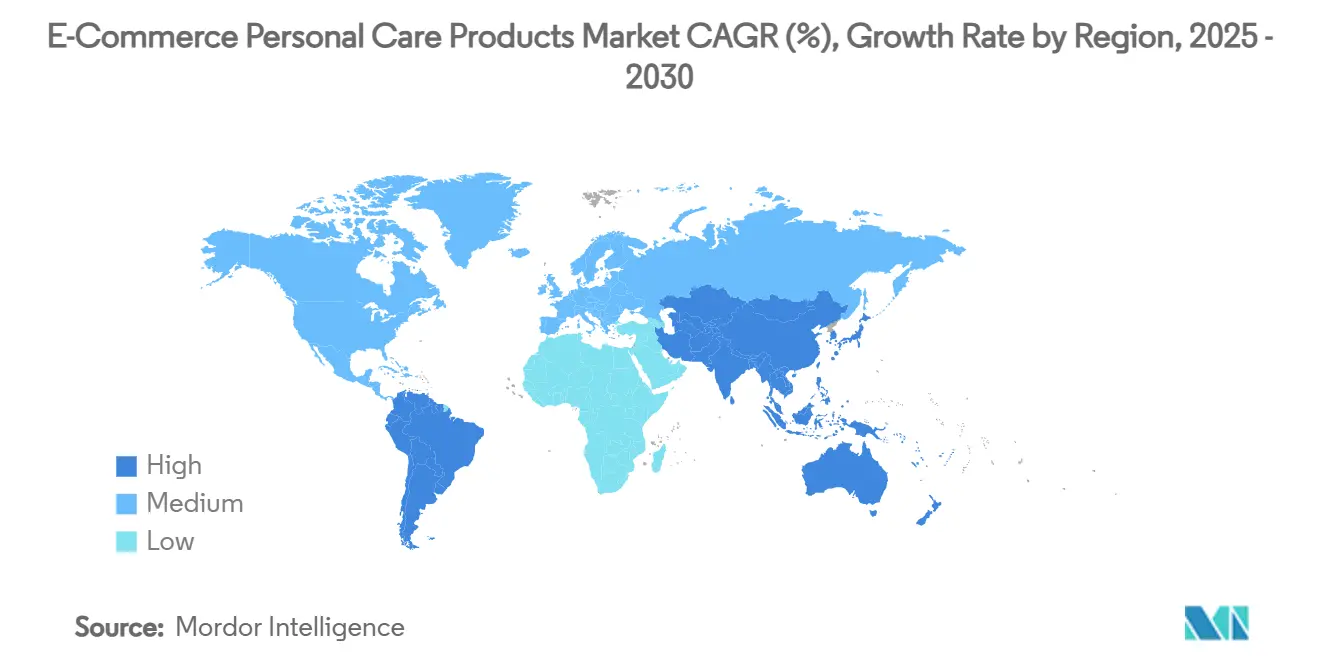
Competitive Landscape
The market maintains moderate consolidation, with established companies such as L'Oréal S.A., Procter & Gamble Company, Unilever PLC, Colgate-Palmolive Company, and Natura & Co Holding SA holding significant market positions. These companies strengthen their presence through innovation and strategic acquisitions. The fragmented nature of the market enables emerging direct-to-consumer brands to establish themselves in niche segments through digital-focused approaches.
Technology integration remains a key focus, as major companies invest in artificial intelligence capabilities, automation, and personalization platforms to enhance their product offerings and improve operational efficiency. For instance, L'Oréal enhanced its technological capabilities in May 2024 by implementing bioprinted skin technology and an AI-powered content laboratory to improve product development. This development illustrates how traditional companies form strategic partnerships to advance their digital capabilities.
The market's competitive dynamics are transforming as new companies implement digital business models, incorporating social media sales channels and strategic content creator partnerships. These organizations are modifying conventional distribution networks through the development of direct-to-consumer sales channels while utilizing customer data analysis to strengthen their competitive positioning in the market.
E-Commerce Personal Care Products Industry Leaders
-
L'Oréal S.A.
-
Procter & Gamble Company
-
Unilever PLC
-
Estée Lauder Companies Inc.
-
Natura & Co Holding SA
- *Disclaimer: Major Players sorted in no particular order
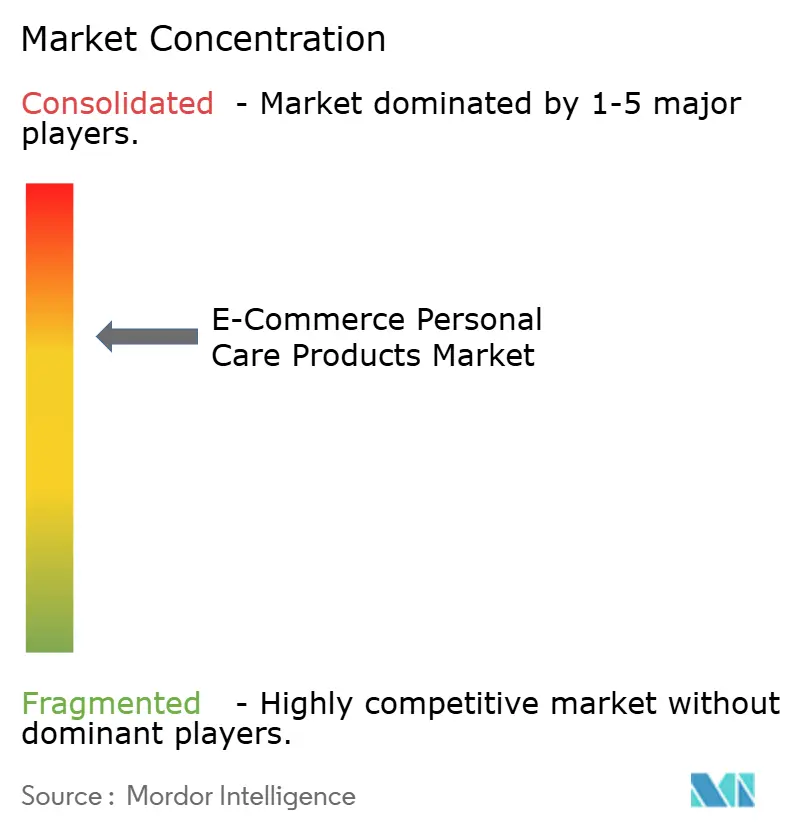
Recent Industry Developments
- May 2025: CHANEL introduced its fragrance and beauty products on Nykaa, making them available through Nykaa's app, website, and select Nykaa Luxe stores across India. The brand maintains a dedicated space on Nykaa's platform where customers can explore and purchase its product range.
- February 2025: Suave Brands Company expanded its beauty product line by introducing 34 new items. The company maintains its focus on providing high-quality products at affordable prices, offering premium performance in everyday personal care items. Suave products are distributed through a network of over 60,000 retail locations across the United States and through Amazon.
- November 2024: The Estée Lauder Companies has expanded its market presence by introducing La Mer, its luxury skincare brand, to the Indian market. The brand's products are now accessible to Indian consumers through e-commerce platforms Tira and Sephora, and select retail stores.
- January 2024: Makeup Revolution expanded its complexion portfolio by introducing two new products - Skin Silk Serum Foundation and Bright Light Face Glow. These products are available for purchase in stores and online at Ulta.com and RevolutionBeauty.US.
Global E-Commerce Personal Care Products Market Report Scope
The e-commerce personal care products market encompasses the online sale of beauty and personal care items. It provides consumers with the convenience of online purchasing from their homes.
The e-commerce personal care products market is segmented based on product type, ingredients, category, platform type, and geography. By product type, the market is segmented into skin care, hair care, lip care, deodorants and antiperspirants, bath & shower, oral care, men's grooming, perfumes & fragrances. Based on ingredients, the market is segmented into conventional and natural/organic. Based on category, the market is segmented into mass and premium. Based on platform type, the market is segmented into third-party retailers and the company's own website. By geography, the market is segmented into North America, Europe, Asia Pacific, South America, the Middle East, and Africa. The market sizing has been done in value terms in USD for all the abovementioned segments.
| Skin Care |
| Hair Care |
| Lip Care |
| Deodorant and Antiperspirant |
| Bath and Shower |
| Oral Care |
| Men’s Grooming |
| Perfumes and Fragrances |
| Conventional |
| Natural/Organic |
| Mass |
| Premium |
| Third-Party Marketplace |
| Company-owned Platform |
| North America | United States |
| Canada | |
| Mexico | |
| Rest of North America | |
| Europe | Germany |
| United Kingdom | |
| Italy | |
| France | |
| Spain | |
| Netherlands | |
| Poland | |
| Belgium | |
| Sweden | |
| Rest of Europe | |
| Asia-Pacific | China |
| India | |
| Japan | |
| Australia | |
| Indonesia | |
| South Korea | |
| Thailand | |
| Singapore | |
| Rest of Asia-Pacific | |
| South America | Brazil |
| Argentina | |
| Colombia | |
| Chile | |
| Peru | |
| Rest of South America | |
| Middle East and Africa | South Africa |
| Saudi Arabia | |
| United Arab Emirates | |
| Nigeria | |
| Egypt | |
| Morocco | |
| Turkey | |
| Rest of Middle East and Africa |
| By Product Type | Skin Care | |
| Hair Care | ||
| Lip Care | ||
| Deodorant and Antiperspirant | ||
| Bath and Shower | ||
| Oral Care | ||
| Men’s Grooming | ||
| Perfumes and Fragrances | ||
| By Ingredients | Conventional | |
| Natural/Organic | ||
| By Category | Mass | |
| Premium | ||
| By Platform Type | Third-Party Marketplace | |
| Company-owned Platform | ||
| By Geography | North America | United States |
| Canada | ||
| Mexico | ||
| Rest of North America | ||
| Europe | Germany | |
| United Kingdom | ||
| Italy | ||
| France | ||
| Spain | ||
| Netherlands | ||
| Poland | ||
| Belgium | ||
| Sweden | ||
| Rest of Europe | ||
| Asia-Pacific | China | |
| India | ||
| Japan | ||
| Australia | ||
| Indonesia | ||
| South Korea | ||
| Thailand | ||
| Singapore | ||
| Rest of Asia-Pacific | ||
| South America | Brazil | |
| Argentina | ||
| Colombia | ||
| Chile | ||
| Peru | ||
| Rest of South America | ||
| Middle East and Africa | South Africa | |
| Saudi Arabia | ||
| United Arab Emirates | ||
| Nigeria | ||
| Egypt | ||
| Morocco | ||
| Turkey | ||
| Rest of Middle East and Africa | ||
Key Questions Answered in the Report
What is the current size of the e-commerce personal care products market?
The market was valued at USD 117.13 billion in 2025 and is projected to reach USD 170.45 billion by 2030.
Which product category leads online beauty sales?
Skin care holds the top position with 41.65% revenue share, driven by preventive wellness trends.
Which region is growing the fastest?
Asia-Pacific shows the highest momentum with a forecast 10.34% CAGR through 2030.
How important are third-party marketplaces?
Marketplaces account for 88.27% of total value, but brand-owned sites are expanding faster as firms seek data control.
Page last updated on:
